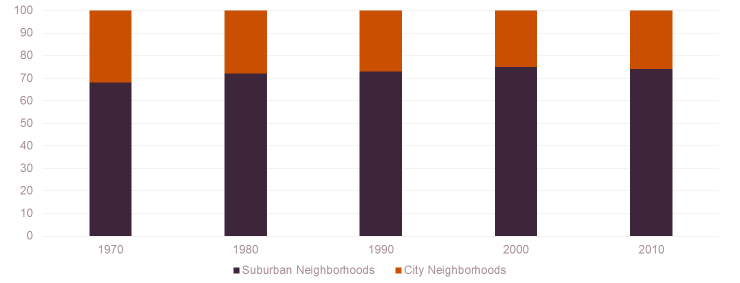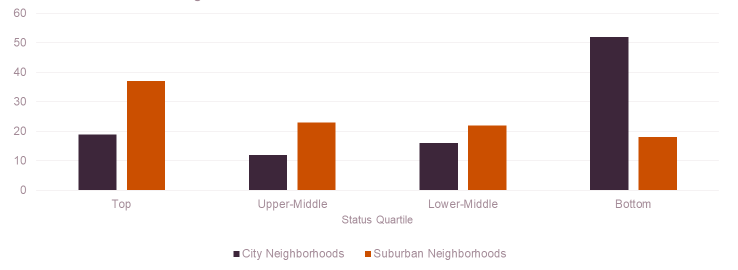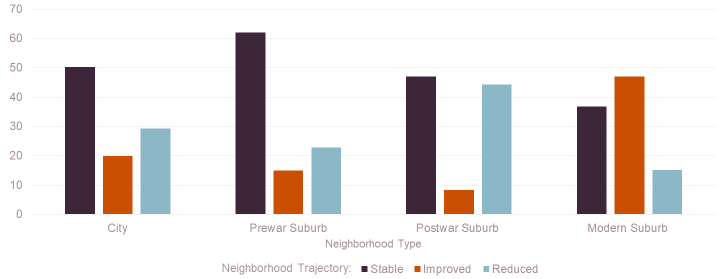Are the Suburbs Losing Status?
The traditional image of suburbs in the United States is one of middle-class, white, family households owning single-family homes. But recent patterns of increasing poverty, greater racial diversity, widespread foreclosures, and fiscal distress in suburbs have challenged this image. Suburbs across the country are increasingly varied while many urban neighborhoods have experienced a resurgence.
Shifts in demographic and housing characteristics have spurred discussion about suburban decline. Popular magazines and websites, for example, have published articles with titles like “The New Suburban Decline”, “Has urban renewal come at the cost of suburban decline?” and “The Suburban Mystique: How the symbol of American prosperity became the new place of poverty.”
In a new paper, “Suburban Status and Neighborhood Change,” recently published online by Urban Studies, I find this common narrative overstates the nature and extent of suburban decline.
To reach this conclusion, I examined status changes from 1970 to 2010 for city and suburban neighborhoods in the nation’s 100 most populous metros. I used Census tracts as a proxy for neighborhoods and defined city and suburban neighborhood types using a modified version of the method developed by Thomas Cooke and Sarah Marchant. I then developed a weighted neighborhood index for each decade from 1970 to 2010 using demographic and housing characteristics. A higher index score was an indicator of higher status relative to other neighborhoods. Using the neighborhood index score, I assigned every neighborhood a status quartile relative to other neighborhoods in the same metro for each decade. Neighborhoods in the top quartile therefore had the highest status while neighborhoods in the bottom quartile were lowest status. Finally, I combined the quartile rankings from each decade into a neighborhood status sequence, categorizing trajectories as reduced, improved, or stable based on how a neighborhood moved across status quartiles over time. An improved status neighborhood, for example, might have started in the bottom status quartile in 1970 but reached the top status quartile by 2010 while a stable status neighborhood remained in the same status quartile throughout the study period.
While there was some evidence of suburban status decline over the study period, I found that high-status neighborhoods were and continue to be disproportionately located in suburban communities. The share of top quartile neighborhoods located in the suburbs rose from 68 percent in 1970 to 75 percent in 2000 before falling slightly to 74 percent in 2010 (Figure 1).
Figure 1: Most high-status neighborhoods are located in suburbs

Source: Author’s analysis of the Longitudinal Tract Database.
Moreover, even when suburban and city neighborhoods were in the same status quartile, the suburban neighborhoods tended to do better than the city ones. For example, residents of suburban neighborhoods in the bottom status quartile had higher median incomes on average than residents of city neighborhoods in the same status quartile.
When considering the trajectories of neighborhoods, I also found that while a stable status sequence is the most common among both cities and suburbs, there were significant differences in the character of that stability. Just over half of stable city neighborhoods were in the lowest status quartile, compared to less than a fifth of suburban neighborhoods (Figure 2). Among neighborhoods that did experience reduced status, city neighborhoods were more likely than suburban ones to decline in status by more than one quartile.
Figure 2: More than half of stable city neighborhoods are in the lowest quartile

Source: Author’s analysis of the Longitudinal Tract Database.
The trajectories show how neighborhoods change in status relative to other neighborhoods in the same metro. But these relative changes may not necessarily correspond to absolute changes in indicators. In a booming metro, for example, incomes and housing values in reduced status neighborhoods could have risen but at rates that were smaller than in stable and improving status areas.
Relative status changes generally did correspond to absolute changes though. Almost three-quarters of reduced status suburban and about 80 percent of reduced status city neighborhoods had real decreases in income over the study period. Conversely, about 90 percent of improving status suburban and city neighborhoods had real increases in income. While median home values and rents increased across all trajectories, they rose substantially slower in reduced and stable status suburban and city neighborhoods than in those with improved relative status.
Finally, there were some notable variations in status trajectory depending on the type of suburban neighborhood. Dense suburban neighborhoods built before 1940 were more likely to be stable while postwar suburban neighborhoods built between 1950 and 1970 were most likely to decline in status (Figure 3). This makes sense given that the start of the study period was when prewar neighborhoods were firmly established and postwar neighborhoods were new and at their peak. Small, postwar housing typically lacks amenities that are currently desired, which may explain the declining status of these neighborhoods over time. In contrast, modern suburban neighborhoods built after 1970 took off over this time and most commonly had improving trajectories.
Figure 3: Postwar suburban neighborhoods were most likely to decline in status
Source: Author’s analysis of the Longitudinal Tract Database.
The findings reorient the narrative of suburban decline by placing suburban neighborhood change relative to the city neighborhoods. The data reveal signs of suburban status decline and urban resurgence, but they also indicate that stability and high-status suburbanization continue to dominate the metropolitan landscape. These dynamics are important to consider as policymakers decide how to distribute finite resources for education, infrastructure, social services, and public safety. In particular, they suggest that while some postwar suburban neighborhoods may require targeted interventions to address status declines, such efforts should not come at the expense of initiatives to invest equitably in the many stable or declining city neighborhoods.


